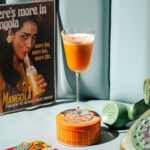Typhoo’s Master Tea Blender, Razi Khan speaks to Peaklife and shares the secrets and facts about the world’s finest teas.
From a cricket player to a tea expert: Razi Khan excels in the art of mastering tea with his deeper knowledge of the blends and regions of tea. Khan started his career as a tea planter and closely worked with McLeod Russel, Carritt Moran & co. and Harris Freeman developing his palate for teas. And, with his travel experiences around the world, he has learnt about tea blends and the various infusions.
Currently Razi Khan is a Tea Expert & Director, Sales and Marketing of Typhoo India. Peaklife met Khan during his recently India visit, and spoke about everything tea and much more…

I understand you are part of an elite group of tea expert around the world. What according to you is a tea expert?
According to me a tea expert is someone, who has explored different parts of the world, has been in different regions, tasted the tea, analysed the tea or herbs or infusion. As you know tea is an agriculture crop, and the weather plays a key role in developing its quality. So, the job of a tea expert is to ensure that irrespective the weather pattern the blend or the recipes remains consistent for the consumers. If a tea expert can do this job then he is an expert, that’s what I would summarize the job of a ‘tea expert’ as.
How did your passion for tea blending start? Tell us about your journey so far?
When I look back, it’s an interesting journey… back then, I was playing lot of sports, and particularly cricket and wanted to play like many others renowned players and I also had a chance to play with Mohammad Kaif. During my visit to Assam I went to a tea farm, where my cousin and his daughters was there, and they asked me, if I want to join a tea garden. I said yes, because the tea garden lifestyle is what seemed very attractive at that point. I joined the tea garden in early 2000 as a tea planter, and that’s where I learnt tea planting in Assam and Darjeeling with the company called McLeod Russel. It was just for two years as I felt I had seen enough and learnt how to plant teas and I was craving to learn more and move on. From there I went on to a tea broking company, Carritt Moran & co. I was there with them for five years. They taught me how to taste tea, value tea and that’s where I was on days tasting 200 to 300 cups of teas. That was my routine the whole day and I would do the same job for 5 day a week. That helped change my pallet and then I challenged myself and moved to a new company again which was more of private label but internationally called Harris Freeman. This was a US based company, and that changed the game for me. I started visiting different regions, for black tea, herbal, and infusion and I learnt every origin is totally different and every tea is different. They trained me practically by giving me the opportunity to travel to all the regions of origin, and tasting the teas in the world and for five years I was with them. Then, in 2010 I joined Typhoo in UK, and have been associated with them ever since. At Typhoo, I am looking after the brand, developing recipes, travelling different location around the world and looking for new ideas and new infusions. And yes, I am still learning and if I look back at my journey, it has been very interesting how different parts of the world have different habits, and as a tea buyer and tea expert, how you can cater to the different palates of different regions.
Tell us about the different types of teas?
Originally, tea comes from a plant called Camellia Sinensis. These days the word ‘tea’ has moved on to a different direction. Anything which you can brew is called tea, and it is no longer from the same plant. If you see green tea or herbal tea, these are also tea as they can be brewed. For me every tea is different. If you ask me which is the best cup of tea for me, I would say I enjoy a different cup and flavour at different time of the day, so there are a lot of flavours that I love.
However, broadly speaking, there are two types of tea. First, the CTC – crush tear and curl, which is a normal tea grown around the world, and the other is the Orthodox tea, which is how green tea and black tea is made. The primary difference between the two is that the orthodox tea has a smoked flavour and CTC is a stronger tea. In terms of L-theanine and caffeine levels both are pretty much similar. I would rate, personally the best tea, if I want to drink a couple of cups will be the Taiwanese oolong tea. It’s called the Alishan oolong, and the second best I would rate Assam orthodox, and the third I will say First Flush Darjeeling tea. The list is endless but I would rate these high because they are grown on specific altitudes, and seasonality is the main key here. I know which time of the year I need to buy these teas, and if I miss that tea in that month then I might not get the same flavour which I want in the blend.
Which according to you is the most exotic tea in the world?
Exotic tea is something which is basically, not available easily. For example, the Hawaiian green, which is very exotic with deep soil pores from high mountains of Hawaii, you won’t get easily as it is not available in lakh of kilograms. Then something like Oriental Beauty in Taiwan which is only grown in 5 to 10 thousand kgs or maybe more, and these exotic teas have been named due to certain reasons, like a story or folklore. The story of the Oriental Beauty from Taiwan is worth a mention. It is about the Queen travelling back to Taiwan when she spots a bug sitting on a small bush. The bug sucks the tea from one lead and the left turns purple, and the Queen instantly fell in love with the beauty of the bush and its colour as she exclaimed ‘Oh Wow.’ Since that day, the tea procured from those bushes were called the Oriental beauty. These tales make a regular tea exotic for me. It’s not only feels beautiful, but it also tastes nice with a floral, delicate and light taste which makes for a refreshing cup of tea.

Which are the regions known for producing the finest teas in India?
India makes one the finest speciality in the world. When I say speciality, for me its Darjeeling, because of the high altitude and it one of the finest growing regions. There is first flush and second flush in Darjeeling, it is delicate and people compare this has champagne of the tea. Assam again, the whole region in Assam which has inherent quality in the soil where the tea gets its high quality from. Nilgiri in South India can replicate the flavour of Ceylon tea as well, for example, if the crop fails in Sri Lanka I have an option to buy from Nilgiri as a blender, and you as a consumer cannot recognize that flavour has come from Ceylon or from Nilgiri, it’s like a secret recipe. Today, some of the finest tea comes from Arunachal Pradesh, there are couple of gardens there and are high grown and have a nice delicate flavours. So, India has diverse regions where some of the rarest teas are produced
If all tea comes from the same plant what makes a cheap tea or a really expensive tea. Is it the quality or something else?
It the various factors, we cannot say it’s cheap, for me every tea has a usage, that’s the art of preparing or blending. Let’s talk about what makes it expensive, the expensive thing comes from altitude of the cultivation, the art of processing, the hygiene factor involved, the seasonality – if there is too much rain and no sun, the flushing won’t be same and quality will be different. The factors like timely harvesting and plucking standards and which is taken care in the field and seasonality should be transferred to the factory and how well the lovely leaf is utilized in the factory. It is about the region and seasonality also, like Sencha tea which comes from Japan. So, it’s the regions and seasonality which determines the cost of teas.
Which is your favourite tea?
Alishan Oolong from Alishan Mountains in Taiwan.
As a tea enthusiast what kind of tea you would suggest, with region, type or flavours?
If you see the statistics of the cities, tea is the second most consumed beverage around the world. And we at Typhoo caters to everyone from millennials to people of different age groups.When you speak about me, I drink 15-20 cups of tea a day and I can enjoy different flavours. In the morning, I have an Assam Orthodox, then by 11, sip on a Darjeeling, and just before lunch I prefer to take a bit of peppermint tea, and post lunch I would go with a Sencha Green Tea or maybe with my lunch also. So, by evening I have a Nilgiri Tea and before going to bed I take a Herbal Tea like fennel or peppermint tea. You see, there is a tea that caters to every hour of the day.









